http://www.rhci-online.net/radiogram/radiogram.htm
http://www.rhci-online.net/radiogram/radiogram.htm
|
RSID: <<2018-06-01T01:25Z MFSK-32 @ 9955000+1500>>
START IBC - ITALIAN BROADCASTING CORPORATION
mail: ibc@europe.com
"IBC DIGITAL" "IBC DIGITAL" IBC - ITALIAN BROADCASTING CORPORATION
mail: ibc@europe.com
|
|
|
RSID: <<2018-06- 02T15:30ZMFSK-32 @ 9400000+1500>>Spawned by Tropical Storm Alberto, a small waterspout forms over a hotel pool in Panama City, Florida ... Sending Pic:123x92C; 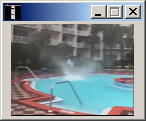 Video: bit.ly/2JgsYdx See also: bit.ly/2IXjgtg Please report decode to themightykbc@gmail.com
|
|

RSID: <<2018-06-01T20:31Z
MFSK-32 @
VIA US-REMOTE 7780000+1500>>
Welcome to program 50 of Shortwave Radiogram.
I'm Kim Andrew Elliott in Arlington, Virginia USA.
Here is the lineup for today's program in MFSK modes as noted:
1:39 MFSK32: Program preview (now)
2:45 MARS urges separation of computers from the internet*
10:26 MFSK64: Methane hydrate - good or bad fuel?*
16:32 Five images*
25:18 MFSK32: Closing announcements*
* with image(s)
Please send reception reports to
radiogram@verizon.net
And visit http://swradiogram.net
Twitter:
@SWRadiogram
From ARRL.org:
MARS Urging Members to Use Computers that are Isolated from the
Internet
05/29/2018
US Army Military Auxiliary Radio System (MARS) Headquarters is
recommending that MARS members "migrate to stand-alone computer
systems for [MARS] radio operations," subject to the availability
of a dedicated computer.
"These computer systems (or their associated local area networks)
should be 'air-gapped' from the internet," Army MARS Headquarters
Operations Officer David McGinnis, K7UXO, said in a message to
members. "Although not a requirement for membership at this time,
we will continue make this a condition of certain parts of our
exercises."
McGinnis pointed to remarks by Cisco researchers in a recent Ars
Technica article about VPNFilter malware: "Hackers possibly
working for an advanced nation have infected more than 500,000
home and small-office routers around the world with malware that
can be used to collect communications, launch attacks on others,
and permanently destroy the devices with a single command."
McGinnis told Army MARS members that MARS Headquarters does not
discuss specific cyber threats with MARS members or with the
public. "We also cannot confirm or deny information about
specific threats," he said, adding that he had "no specific
knowledge" about VPNFilter malware and no comment on the Cisco
report.
For communication exercises this year, MARS established
conditions for a certain portion of the drill that requires use
of standalone computer systems "normally not connected to the
internet."
MARS member and software consultant Steve Hajducek, N2CKH, has
recommend that members using the MIL-STD (military standard) Data
Modem Terminal (MS-DMT) communications software employ
stand-alone computers in conjunction with the software as a best
practice for achieving a high level of performance. McGinnis said
discussion of stand-alone computer systems on Hadjuceks's support
forums and their use in communications exercises let Army MARS
Headquarters weigh in on the discussion. He pointed out that the
MARS mission assumes that an internet connection is not
available. He said used or refurbished PCs are widely available
at low cost and could be dedicated to serve a stand-alone
function.
"The most effective way to protect against threats that come from
the internet is to isolate from the internet," McGinnis added.
"Despite a stand-alone environment, we assume that all computer
systems in private citizens' hands are infected with hostile
software code of some sort and are not secured," he said. "No
amount of virus and malware scanning software changes that
assumption. We can, however, isolate computers by disconnecting
them from the international network in which hostile software
will report and receive instruction."
McGinnis said future versions of MARS software will check for an
internet connection and will disable the software. "We understand
this lock-out does not provide security in and of itself; rather,
its value is in changing the behavior of members," he explained.
He encouraged MARS to monitor for internet security threats and
determine how to secure their internet-connected and stand-alone
devices.
MARS Program Manager Paul English, WD8DBY, told ARRL that the
MARS goal is to isolate MARS members' computers from the internet
as much as possible. "Having stand-alone computers running as few
other resources than MARS-related software improves the overall
MIL-STD system software performance and further isolates
computers from infections, malware, and hacking," he said.
English added that isolating the computers that members use for
MARS-related activity is "a goal, but has not been directed."
http://www.arrl.org/news/mars-urging-members-to-use-computers-that-are-isolated-from-the-internet
Sending Pic:181x172C;
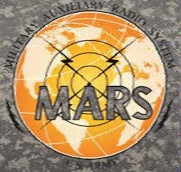
Shortwave Radiogram now changes to MFSK64 ...
RSID: <<2018-06-01T20:40Z
MFSK-64 @
7780000+1500>>
This is Shortwave Radiogram in MFSK64
Please send reception reports to
radiogram@verizon.net
From Deutsche Welle:
Fire and ice: The untapped fossil fuel that could save or ruin
our climate
Methane hydrate buried below permafrost and the ocean floor
could meet the world's energy needs for 100 years Ė but
would extracting it be catastrophic for the climate?
Sandy Hausman
31 May 2018
When we think of the planet's diminishing fossil fuel reserves,
we might picture oilfields, coal gouged from open-pit mines, or
the controversial business of fracking to extract shale gas that
was once beyond our technical reach.
But what if earth's biggest store of fossil fuels was in fact a
little-known, and even less accessible, untapped source of
natural gas?
Beneath the sea floor, methane is trapped in ice crystals under
high pressure and extremely low temperatures. The resulting
substance is sometimes called "fire and ice."
"You will find YouTube videos of this," Steve Holbrook, professor
of geosciences at Virginia Polytechnic Institute told DW.
"You hold a lighter or a match to it, and it will ignite. For a
few minutes you can actually have burning ice. The match is
igniting the methane gas that's been released. At the end of that
you've just got a puddle of water left."
The scientific name for this energy source is methane hydrate.
Another 100 years of hydrocarbons?
It's found in two places on earth Ė under the ocean floor, and
beneath Arctic permafrost. Deposits can be hundreds of meters
deep and scientists say it could be more prevalent than any other
fossil fuel.
"Methane hydrate has the potential to extend the fossil fuel age
by a century or more," Richard Charter, a senior fellow with The
Ocean Foundation told DW. "There may be more methane hydrate out
there than all of the remaining oil and gas."
Methane is a natural gas that contains carbon. Burning it
releases less CO2 into the atmosphere than coal or oil, but
emissions still contribute to climate change.
Worse, methane itself is a greenhouse gas that's about 30 times
more potent than carbon dioxide. If it's not extracted carefully,
leaks pose a real risk to the climate.
"That would accelerate warming of the seas and melting of
permafrost, which could, in turn, cause the release of even more
methane," Charter said. "We could end up frying the planet."
Charter has been studying methane hydrate for more than 50 years
and says there is still much to learn about how it behaves under
different conditions.
We do know that when methane is freed from its icy confines it
expands rapidly, creating a risk of explosion. In fact, some
scientists think methane hydrate, which is plentiful in the Gulf
of Mexico, was to blame for the blast there that led to the BP
oil spill in 2010.
The fossil fuel that captures carbon?
But accessing this volatile hydrocarbon might not be all bad news
for the climate.
Charter has long been fascinated by methane hydrate's ability to
hold carbon in place. If scientists found a way to replace the
methane in hydrate deposits with excess carbon dioxide, it might
be possible to remove greenhouse gases from the atmosphere while
extracting methane for fuel.
A team of scientists from the United States and Japan made a
breakthrough in 2012. They drilled into a methane hydrate deposit
on the North Slope of Alaska, and injected a mix of carbon
dioxide and nitrogen into the well.
They then reduced the pressure, releasing methane. Over a two-day
period, the amount of carbon dioxide leaving the well dropped
while the amount of methane rose, suggesting the carbon dioxide
was captured by the hydrate compound.
Scientists say much more research is needed before commercial
drilling for methane hydrate is possible. To this end, the US
Department of Energy recently launched a six-year, $80 million
(Ä65 million) project to drill core samples of methane hydrate
from the Gulf of Mexico.
"It's a delicate task that requires transporting samples from
great depths to the surface without depressurizing them," Peter
Flemings, a geoscientist at the University of Texas and the
project's principal investigator, told DW.
The cost and technical challenges of mining methane hydrate mean
it's a long way from being commercially viable, particularly in
North America where gas and oil are relatively cheap.
Race for the new fracking
But Flemings says that could change as the science improves.
"This could be analogous to shale 30 years ago," he said. "None
of us thought we were going to produce oil and gas out of shale
back then."
India and China are also looking into exploiting under-sea
reserves, while Russia and Canada focus on extracting it from
beneath permafrost.
"Russia and Canada have done a lot because they have vast arctic
territories where methane hydrate is known to exist in
permafrost," Holbrook said. "They have done cutting-edge work
both in understanding the reservoir and in experimenting with
ways to try to produce it."
Countries with few energy resources may be the first to find
extracting methane hydrate financially attractive. Since the
nuclear disaster at Fukushima, Japan for example, has been forced
to import large quantities of expensive liquefied natural gas.
"Japan is frantically trying to develop an industry because they
have hydrates off their coast," Charter said. But he believes it
will be another decade before it's clear whether methane hydrate
extraction is a viable proposition, even for Japan.
Until then, fire and ice's potential to slow or hasten climate
change remains an unknown quantity in our energy future.
http://www.dw.com/en/fire-and-ice-the-untapped-fossil-fuel-that-could-save-or-ruin-our-climate/a-43246890
Image: Burning methane hydrates ...
Sending Pic:222x128C;
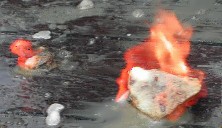
This is Shortwave Radiogram.
Please send reception reports to
radiogram@verizon.net
Image: A dust devil interrupts a baseball game in Libertyville,
Illinois ...
Sending Pic:223x130C;
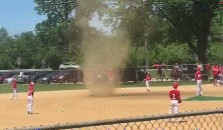
https://wapo.st/2LPOZhI
See also:
https://wapo.st/2JggD9k
See also a waterspout in a hotel swimming pool:
https://bit.ly/2JgsYdx
Image: US temperatures were lower than normal (purple, green,
blue) in April, but warmer than normal in May (red and redder)
...
Sending Pic:273x92C;

https://wapo.st/2LMob27
Image: 30 May was "Manhattanhenge," one of the four days per year
that sunset lines up with the (not quite) east-west streets in
the New York City borough of Manhattan ...
Sending Pic:152x223C;

https://bit.ly/2IWYWw6
Image: If you travel through northern Indiana (my home region),
visit the East Race Waterway in South Bend. It's "the first
man-made white water rafting course built in North America."
Sending Pic:141x223C;
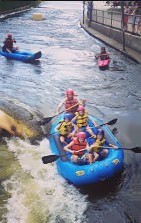
https://visitsouthbend.com/white-water-rafting-in-downtown-south-bend/
Image: Three of Saturn's oddly shaped moons, from left: Pan,
Atlas and Prometheus ...
Sending Pic:343x98;

A University of Bern study suggests how they acquired these
shapes. See
https://www.sciencenews.org/article/saturn-moons-shapes-collisions/
Shortwave Radiogram now returns to MFSK32 ...
RSID: <<2018-06-01T20:55Z
MFSK-32 @
7780000+1500>>
This is Shortwave Radiogram in MFSK32 ...
Transmission of Shortwave Radiogram is provided by:
WRMI, Radio Miami International, http://wrmi.net
and
Space Line, Bulgaria, http://spaceline.bg
Please send reception reports to
radiogram@verizon.net
And visit http://swradiogram.net
Twitter:
@SWRadiogram
I'm Kim Elliott. Please join us for the next Shortwave
Radiogram.
Sending Pic:192x151C;
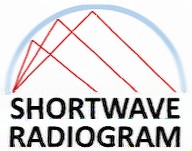
|
Ending song:
"Dust
Devils" by Mary McCaslin https://www.youtube.com/watch?v=_wUZNApQ2Xk
|

http://www.rhci-online.net/radiogram/radiogram.htm
|
QTH: |
D-06193 Petersberg (Germany/Germania) |
|
|
Ant.: |
Dipol for 40m-Band & Boomerang Antenna 11m-Band |
|
|
RX for RF: |
FRG-100B + IF-mixer & ICOM IC-R75 + IF-mixer |
|
|
Software IF: |
con STUDIO1 - Software italiano per SDR [S-AM-USB/LSB] + HDSDR 2.76 stable [2017-02-02] - for scheduled IF-recording |
|
|
Software AF: |
Fldigi-4.00.12 + flmsg-4.0.3 images-fldigifiles on homedrive.lnk |
|
|
OS: |
German XP-SP3 with support for asian languages |
German W7 32bit + 64bit |
|
PC: |
MEDION Titanium 8008 (since 2003) [ P4 - 2,6 GHz] |
MSI-CR70-2MP345W7 (since2014) [i5 -P3560 ( 2 x 2,6GHz) ] |

Welcome to BSR Radiogram #11, a production of James M. Branum (KG5JST) and
BroadSpectrumRadio.com.
In this episode:
1. Some discussion of my recent experiences using WSPR for the first time.
2. A birthday fundraiser to help me purchase air time for BSR.
3. "Branum's Stamp Radio"
As always your QSL reports are always welcome at
broadspectrumradio@gmail.com.
+++++++++++++++++++++++
1. The world of WSPR
Due to financial limitations, I have mostly been a QRP radio amateur. My first
(and thus far only) HF transceiver, has been the Yaesu FT-817, a very versatile
all-band/mode transceiver, but one that can only do 5 watts, which has resulted
in my having mostly
frustrating experiences as an operator. I have had a few DX HF QSO's (to
Pennsylvania, Utah and Montana) in SSB mode, but that's about it. I know
conventional wisdom for QRP operators is to go with CW (morse code), but I never
stuck with the learning process long
enough to get good at it, so my next choice was to consider digital modes.
So recently I learned about WSPR (weak signal propogation reporter network) and
decided to give it a try. Initially my setup was my Yaesu FT-817 going to my
MFJ-9201 backpacker antenna tuner and then feeding to a 20 meter interted V
dipole in the backyard (right now
only a measly 8 foot off the ground). As for the digital part of the process,
I've been using the WSPR beacon android app, connected to my transceiver via a wolphilink interface, which allowed me to start running a WSPR beacon.
My expectations were low (and it took a bit of tweaking to get the RX/TX gain
setting on the interface correctly configured) but very quickly I started seeing
my transmissions spotted all over the place --- as of the time of this writing,
I've had my signal spotted
by more than 150 locations in 32 US States, 5 Canadian provinces and 7 countries
(USA, Canada, Venezuela, Belgium, Luxembourgh, England & Germany). Most of these
spots were on the 20 and 30 meter bands, but I've had spots on 10 and 40 meters
as well.
On the receiving end, I just started doing that tonight. I haven't found an
android app that will do the decoding, so instead I'm running an audio cable
from the headphone jack on my transceiever to the microphone jack on my PC and
then using the WSPR software for
decoding as well as for spotting. And almost immediately I was able to receive a
signal from HK3J, 4200+ km away in Columbia!
So I'm a fan of WSPR. It is absolutely the most fun I've had on ham radio since
getting licensed.
The next step for me will be to experiment with other slow digital modes that
can handle low power and high noise, but ideally let me make actual QSO's and
not just send or receive beacons. I also am determined to improve my antenna
situation.
So here are a few maps that show my success with WSPR thus far...
de KG5JST k
Sending Pic:500x255C;
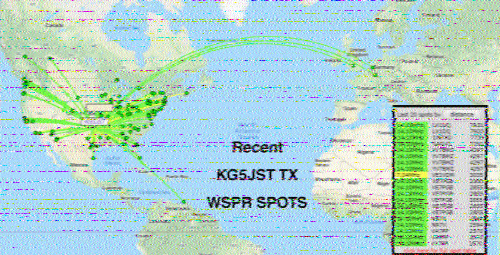
Sending Pic:500x243C;
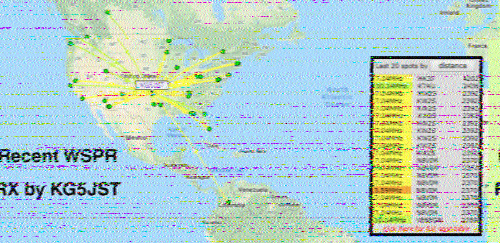
+++++++++++++++++++++++
2. A birthday fundraiser to help me purchase air time for BSR.
From:
http://broadspectrumradio.com/2018/06/02/a-birthday-fundraiser-help-james-to-be-able-to-keep-airing-new-programs-from-bsr/
Lots of folks on social media (facebook, twitter, etc.) use their birthdays as
an excuse to do a fundraiser for a cause dear to themselves, and I am no
exception.
Next week I am turning 42, so Iím going to use my birthday as an opportunity to
ask for donations to help my project, Broad Spectrum Radio.
Currently I am airing a weekly program, the BSR International Magazine Show on
International Shortwave Radio station WRMI in Okeechobee, Florida. Reception
range varies, but over the last few months Iíve received reception reports and
listener feed back from all over
North America as well as Mexico, Hawaii, New Zealand and Australia.
The first half hour is a mix of talk and music, focusing on the 4 Sís ó
Solidarity (for all oppressed peoples), Socialism (of the democratic grassroots
variety), Spirituality (focusing on a humanistic approach to religion and
spirituality) and Science (focusing on
the radio hobbyist and DIY communities). This is a mix unlike anything else on
the radio, but is especially uncommon on shortwave radio.
The second half hour is, the BSR Radiogram, a digital mode program modeled after
the famous ďVOA RadiogramĒ, which listeners are able to decode using computer
software on their computer, cell phones or tablets, which enables me to send
text, pictures and other
content via the radio waves.
Iím paying $30 per week to air these programs, with most of these funds coming
from my own pocket (with the remainder right now coming from the Center for
Conscience in Action - centerforconscience.org), but I donít know how long I can
continue to do this. At the
same time, Iím getting more frequent listeners responses than I have ever
received (particularly with the digital format program) so I really want this to
continue. So my goal with this campaign is to raise $780, enough to air the
program for the next 26 weeks.
I should mention of course that I do put my programs online as well, where they
can be heard in podcast form, but from what I can tell I have more devoted and
dedicated listeners on OTA (over the air) radio, but also OTA radio has the
possibility to reach audiences
in places with limited internet access as well as governmental censorship, so I
do not think that online broadcasting will ever substitute entirely for OTA
broadcasting.
So if you would like to help, your donations will make a huge difference.
Donations can be made to me via paypal here:
https://www.paypal.com/cgi-bin/webscr?cmd=_s-xclick&hosted_button_id=6XREXD3VDEMGW
Or can be made by check (in US dollars) sent to: James M. Branum, 504 NE 16th
St., Oklahoma City, OK 73104, USA.
And as an added bonus, I will be sure and mention the names of all donors on
both the BSR International Magazine Show (the first half hour) as well as the BSR International Radiogram (for the digital format show, I can include a
picture of your choice, no larger than
200◊200 pixels ó but please no sexist, racist, homophobic, or otherwise
offensive pictures)
Important note on tax deductions: Since BSR Media does sometimes air US
electoral political commentary, donations are NOT tax-deductible under US law. ó
But if you would like to support the non-political programming of BSR and also
get a tax deduction, you can
instead make a donation to the Center for Conscience in Action and earmark it to
pay for the airing of cultural/educational content through BSR (just shoot me an
email at broadspectrumradio at gmail dot com, so I can be looking for the
donation and keep it properly
earmarked).
Sending Pic:400x400C;
 |
|
Sending Pic:250x201C;
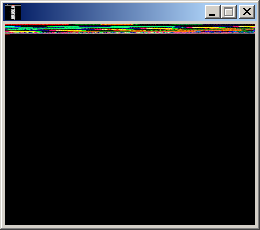
+++++++++++++++++++++++
3. "Branum's stamp radio"
One of my respondents on facebook said that I was broadcasting a lot pictures of
stamps, but that it was ok since the BSR Radiogram could stand for "Branum's
Stamp Radio" instead of just "Broad Spectrum Radio."
I like this joke because I got into stamp collecting by way of my grandpa, the
late James Burton "J.B." Branum, Jr (1919-1988), who was the co-owner (with his
wife Roberta) of Branum's Variety Store in Minco, Oklahoma.
So here's a picture of some my family (JB and Roberta are both in wheelchairs
and I'm the cute kid in the front row, one over from the right side --- also in
this picture are my parents, my brother John, my maternal grandparents and one
of my great-grandmothers) and
after that is a stamp.
Sending Pic:250x201C;
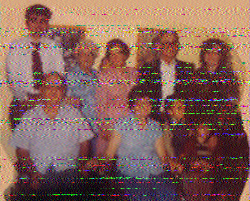 |
|
Sending Pic:169x260C;
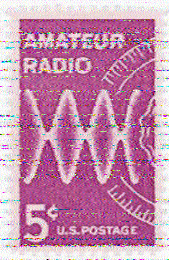 |
|